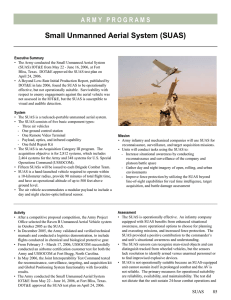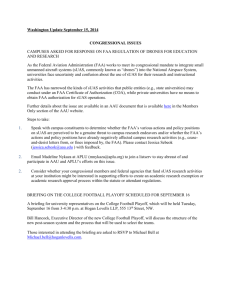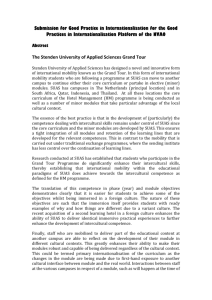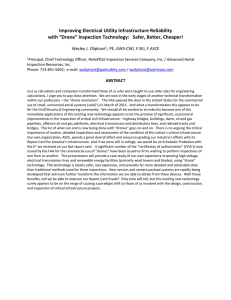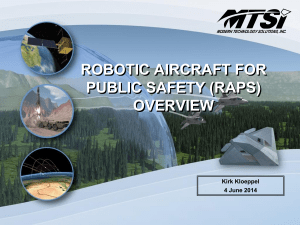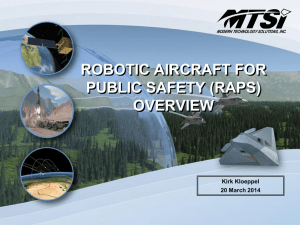A n n e x B -... Small Unmanned Aerial System (SUAS)
advertisement
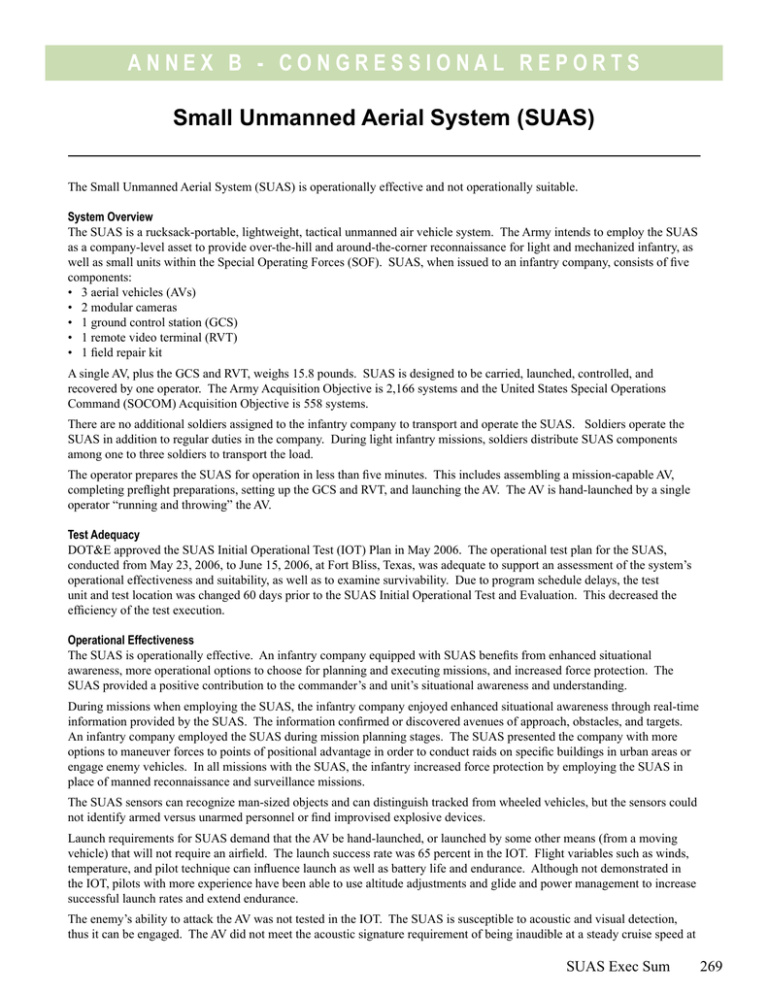
Annex B - congressional reports Small Unmanned Aerial System (SUAS) The Small Unmanned Aerial System (SUAS) is operationally effective and not operationally suitable. System Overview The SUAS is a rucksack-portable, lightweight, tactical unmanned air vehicle system. The Army intends to employ the SUAS as a company-level asset to provide over-the-hill and around-the-corner reconnaissance for light and mechanized infantry, as well as small units within the Special Operating Forces (SOF). SUAS, when issued to an infantry company, consists of five components: • 3 aerial vehicles (AVs) • 2 modular cameras • 1 ground control station (GCS) • 1 remote video terminal (RVT) • 1 field repair kit A single AV, plus the GCS and RVT, weighs 15.8 pounds. SUAS is designed to be carried, launched, controlled, and recovered by one operator. The Army Acquisition Objective is 2,166 systems and the United States Special Operations Command (SOCOM) Acquisition Objective is 558 systems. There are no additional soldiers assigned to the infantry company to transport and operate the SUAS. Soldiers operate the SUAS in addition to regular duties in the company. During light infantry missions, soldiers distribute SUAS components among one to three soldiers to transport the load. The operator prepares the SUAS for operation in less than five minutes. This includes assembling a mission-capable AV, completing preflight preparations, setting up the GCS and RVT, and launching the AV. The AV is hand-launched by a single operator “running and throwing” the AV. Test Adequacy DOT&E approved the SUAS Initial Operational Test (IOT) Plan in May 2006. The operational test plan for the SUAS, conducted from May 23, 2006, to June 15, 2006, at Fort Bliss, Texas, was adequate to support an assessment of the system’s operational effectiveness and suitability, as well as to examine survivability. Due to program schedule delays, the test unit and test location was changed 60 days prior to the SUAS Initial Operational Test and Evaluation. This decreased the efficiency of the test execution. Operational Effectiveness The SUAS is operationally effective. An infantry company equipped with SUAS benefits from enhanced situational awareness, more operational options to choose for planning and executing missions, and increased force protection. The SUAS provided a positive contribution to the commander’s and unit’s situational awareness and understanding. During missions when employing the SUAS, the infantry company enjoyed enhanced situational awareness through real-time information provided by the SUAS. The information confirmed or discovered avenues of approach, obstacles, and targets. An infantry company employed the SUAS during mission planning stages. The SUAS presented the company with more options to maneuver forces to points of positional advantage in order to conduct raids on specific buildings in urban areas or engage enemy vehicles. In all missions with the SUAS, the infantry increased force protection by employing the SUAS in place of manned reconnaissance and surveillance missions. The SUAS sensors can recognize man-sized objects and can distinguish tracked from wheeled vehicles, but the sensors could not identify armed versus unarmed personnel or find improvised explosive devices. Launch requirements for SUAS demand that the AV be hand-launched, or launched by some other means (from a moving vehicle) that will not require an airfield. The launch success rate was 65 percent in the IOT. Flight variables such as winds, temperature, and pilot technique can influence launch as well as battery life and endurance. Although not demonstrated in the IOT, pilots with more experience have been able to use altitude adjustments and glide and power management to increase successful launch rates and extend endurance. The enemy’s ability to attack the AV was not tested in the IOT. The SUAS is susceptible to acoustic and visual detection, thus it can be engaged. The AV did not meet the acoustic signature requirement of being inaudible at a steady cruise speed at SUAS Exec Sum 269 Annex B - congressional reports a maximum of 400 feet above ground level. The AV can be visually detected during the day, permitting observers to track the AV on its return leg to the recovery site. Operational Suitability SUAS is not operationally suitable because an SUAS-equipped unit cannot sustain itself in prolonged combat and the AV is not reliable. The primary measures for operational suitability are reliability, availability, and maintainability. The test did not dictate that the unit sustain 24-hour combat operations, and the forward repair area was artificially co-located with the infantry unit. These test artificialities provided an overly optimistic estimate for operational availability. The system consumed parts, especially vehicle fuselages, at a rate in excess of current parts allocation. Although the operators were able to adequately perform and complete most required repairs within five to six minutes, these repairs had varied impact on mission performance, from delay in launch time to system aborts. The AV did not meet reliability requirements, averaging one essential function failure during each mission. Operators had to replace some part of the AV every time they wanted to fly it. The demonstrated AV reliability was 5.6 hours Mean Time Between System Abort versus a requirement of 12 hours Mean Time Between System Abort. In certain types of units, the Army should consider adding additional AVs until the poor reliability is corrected. The proximity of the forward repair area to the unit during the IOT and the usage of spare parts beyond those normally allocated to a brigade contributed to artificially high operational availability rates. Had the forward repair area been located at a doctrinal representative distance, logistics delay times would increase and the operational availability would potentially be reduced. Recommendations The Army should consider: 1.Improving the reliability of the AV by increasing the number of parts in the spares package and re-examining the allocation of spares between operators and depot maintenance. 2.Adding more aerial vehicles until the reliability of the aerial vehicles increases, consistent with the mission or type unit. 3.Exploiting the full potential of the SUAS by developing and refining tactics, techniques, and procedures for dismounted and mechanized infantry to fully utilize the SUAS, to include airspace de-confliction procedures. 270 SUAS Exec Sum
